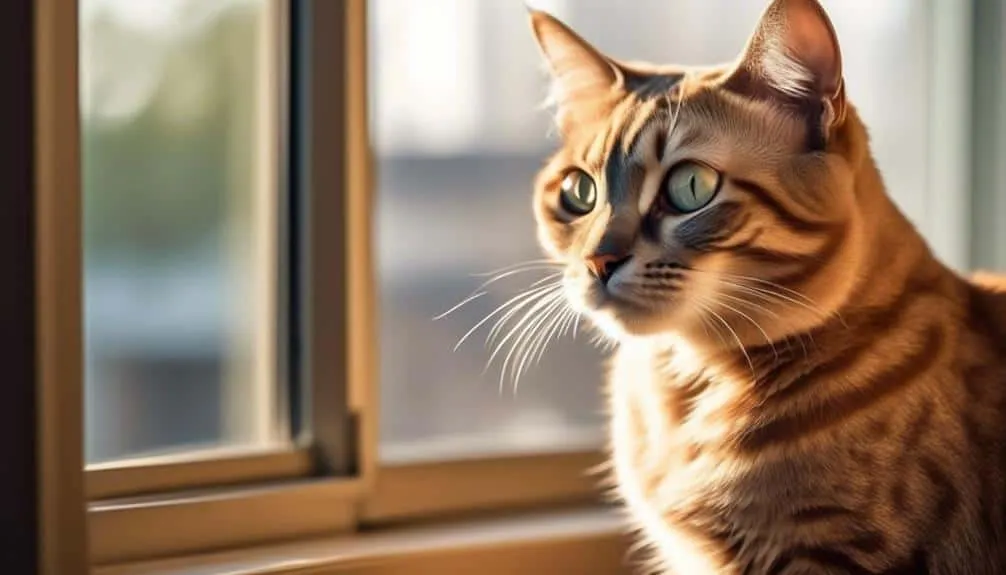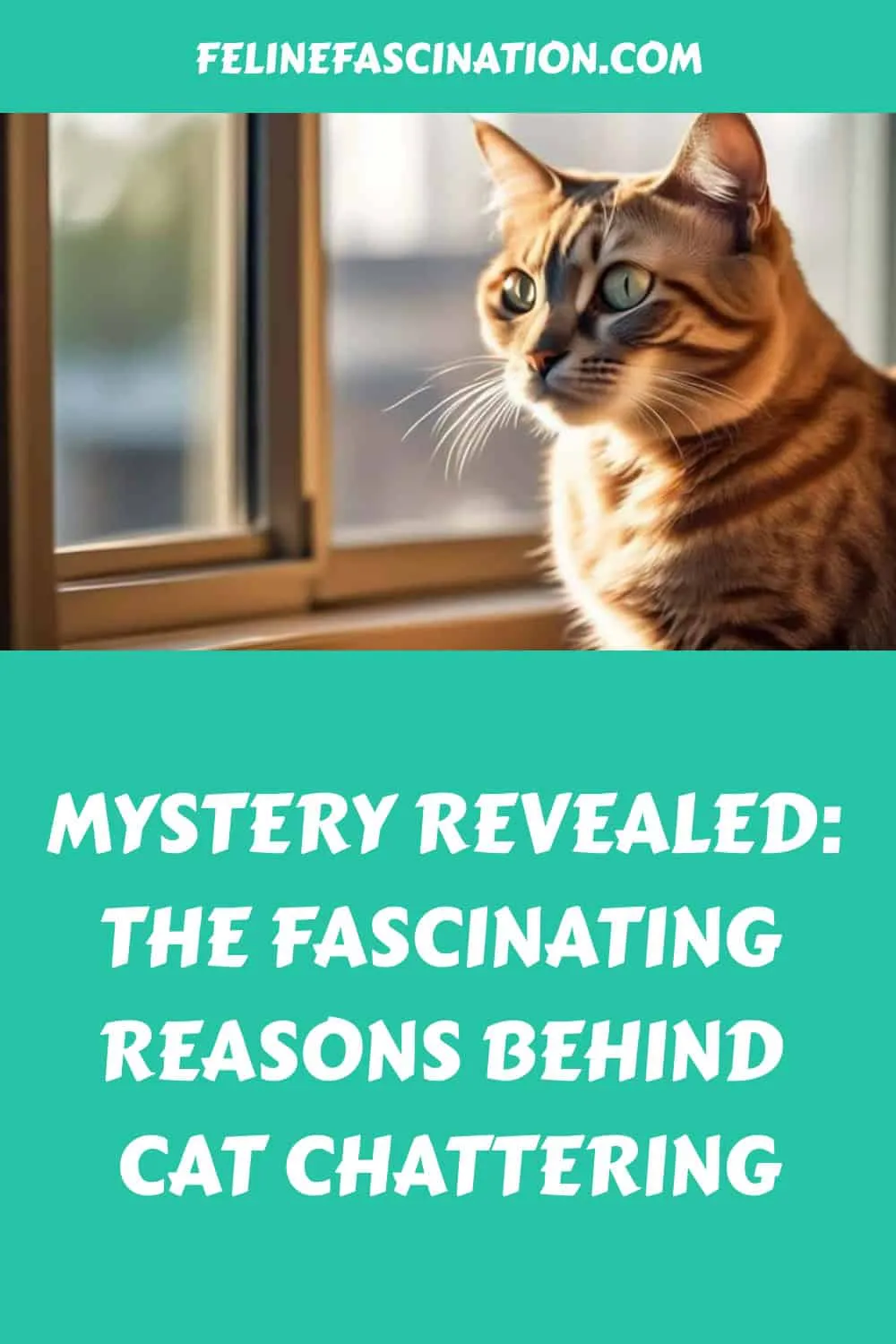The Best Fluffy Pancakes recipe you will fall in love with. Full of tips and tricks to help you make the best pancakes.

Have you ever wondered why your cat chatters at birds or other prey animals? It's a behavior that may seem mysterious at first, but there are actually fascinating reasons behind it.
From evolutionary responses to communication between cats, there are various theories that attempt to explain this intriguing behavior.
By understanding the motivations behind cat chattering, you can better meet your feline friend's needs and provide them with the appropriate mental and physical stimulation.
So, let's explore the secrets behind this captivating behavior and unravel the mysteries that lie within.
Key Takeaways
- Cat chattering can be a result of excitement, anticipation, and frustration mixed with excitement.
- Chattering may be a way for cats to mimic the sounds of their prey and practice their hunting skills.
- It is not a form of communication between cats or a way to coordinate group hunting tactics.
- Providing mental stimulation through interactive play sessions and toys can help alleviate frustration and satisfy a cat's natural hunting instincts.
Reasons for Cat Chattering
Cat chattering is a fascinating behavior exhibited by cats and is believed to serve multiple purposes, including expressing excitement, frustration, and practicing hunting skills. This behavior holds evolutionary significance as it may be an evolutionary response to watching prey just out of reach.
By mimicking the sounds of their prey, cats may be practicing or warming up for the killing bite. This behavior also has communication implications, as some believe that chattering is a form of feline role play, imagining catching the prey. It could also be a way for cats to attract their prey by making the same sound.
However, it's important to note that cat chattering isn't a form of communication between cats or for coordinating group hunting tactics. Understanding the reasons behind cat chattering can help provide appropriate toys and stimulation to satisfy their natural instincts.
Evolutionary Response to Prey
The evolutionary response to prey can be observed in the fascinating behavior of cat chattering. This behavior provides cats with an evolutionary advantage by allowing them to practice and prepare for the killing bite.
It's believed that chattering is a manifestation of their predatory instincts, as they mimic the sounds of their prey to attract and lure them in. This mimicry tactic is particularly beneficial for ambush predators like cats, as it increases their chances of successfully capturing their prey.
Additionally, chattering may be a last resort effort to attract prey that's just out of reach, indicating the cat's frustration mixed with excitement.
Release Valve for Excitement
With an understanding of the fascinating evolutionary response to prey, it's intriguing to delve into the concept of cat chattering as a release valve for excitement.
When a cat becomes excited, whether it's from anticipation of pouncing on prey or engaging in play behavior, adrenaline is released into their system. Adrenaline is known to increase heart rate, blood pressure, and overall arousal.
Cat chattering may serve as a physical outlet for this heightened state of excitement, allowing the cat to release pent-up energy and frustration. It's possible that chattering serves a similar purpose as play behavior, providing a means for cats to practice and warm-up for the killing bite.
By chattering, cats may also be mimicking the sounds of their prey, enhancing the excitement of the hunt.
Understanding the role of adrenaline and the connection between cat chattering and play behavior can help us provide appropriate outlets for our feline companions' excitement.
Frustration Mixed With Excitement
When experiencing heightened excitement, cats may display a unique combination of frustration and anticipation, resulting in the phenomenon known as cat chattering. This behavior is believed to be a way for cats to manage their frustration while eagerly anticipating their prey.
The impact of chattering on dental health is an important consideration for cat owners. Chattering can be a normal behavior, but if it occurs after a meal, it could indicate dental or oral pain and should be evaluated by a veterinarian.
To manage frustration and provide mental stimulation, regular interactive play sessions with toys are recommended. Bird watching and interactive toys that mimic flying prey can encourage cat chattering in a safe and enjoyable way.
It's crucial to understand the reasons behind cat chattering to provide appropriate toys and stimulation for our feline companions.
Practice or Warm-Up for Killing Bite
Cats may engage in chattering as a way to practice and warm-up for their killing bite. This behavior is deeply rooted in their predatory instincts.
Chattering serves as a practice technique, allowing cats to refine their hunting skills and prepare for successful prey capture. By mimicking the sounds of their potential victims, such as birds or small mammals, cats can simulate the final moments before delivering a killing bite.
This behavior not only helps cats sharpen their reflexes, but also allows them to assess the timing and precision required for a successful hunt. Through chattering, cats can fine-tune their coordination and ensure that their killing bite is accurate and lethal.
Mimicking Sounds of Prey
Mimicking the sounds of their prey, cats engage in chattering as a strategic exercise to simulate the final moments before delivering a killing bite. This mimicry tactic in cat hunting behavior serves multiple purposes in their quest to attract prey.
Sound communication in cat prey attraction:
- Chattering allows cats to imitate the calls and noises made by their potential prey, such as birds or monkeys, effectively luring them closer.
- By mimicking the sounds of their prey, cats create a sense of familiarity and enticement, increasing the chances of a successful hunt.
Through this mimicry, cats exhibit their innate hunting skills and enhance their chances of catching elusive prey. The ability to accurately replicate the sounds of their quarry showcases their adaptability and cunning.
Feline Role Play
By exploring the phenomenon of cat chattering and its role in mimicking the sounds of prey, we can now delve into the intriguing concept of feline role play.
Feline role play refers to the behavior exhibited by cats when they engage in activities that mimic hunting and capturing prey. This behavior serves several purposes, including the refinement of their hunting skills, the release of pent-up energy, and the stimulation of their natural instincts.
The role of mimicry in cat chattering becomes evident in feline role play, as cats attempt to imitate the sounds and movements of their prey. This mimicry allows cats to practice their hunting techniques and mentally prepare for the act of capturing their prey.
Through feline role play, cats are able to satisfy their natural predatory instincts and fulfill their need for mental and physical stimulation. Understanding the role of mimicry in cat chattering can help us provide appropriate outlets for their hunting behavior and ensure their overall well-being.
Drawing Prey in With Sound
Drawing prey in with sound is a strategic tactic utilized by cats during hunting to mimic the sounds of their potential prey and entice them closer. This behavior is a result of the cat's innate ability to imitate the vocalizations of its prey, such as birds or mice.
By mimicking the sounds made by their potential meals, cats are able to attract the attention of their prey and lure them within striking distance. This tactic is particularly effective for ambush predators like cats, as it allows them to remain hidden while still drawing their prey closer.
Other Theories on Cat Chattering
One possible explanation for cat chattering revolves around the idea that it serves as a way for cats to release pent-up energy and frustration. While chattering is often associated with excitement and anticipation, it may also be a result of cats needing an outlet for their excess energy.
Cats are natural hunters, and when they're unable to release their energy through physical activity, it can build up and manifest as chattering. Additionally, frustration can arise when cats are unable to reach their desired prey or engage in their natural hunting behaviors. Chattering may serve as a way for cats to communicate their frustration to other cats, signaling their need for release.
Conclusion
In conclusion, cat chattering is a fascinating behavior with multiple intriguing theories behind it. From mimicking the sounds of prey to releasing pent-up energy, this behavior serves various purposes for our feline friends.
By understanding the reasons behind cat chattering, we can ensure that our cats receive the appropriate mental and physical stimulation they need. So, next time you witness your cat chattering at birds, remember that it's their way of engaging with the captivating world around them.










